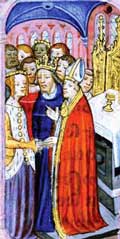Eleanor of Aquitaine
Eleanor of Aquitaine was one of the most important women of the Middle Ages, a strong political player and a patron of great literary personalities like Chrétien de Troyes.
She was born in 1122 as the daughter of William X, Duke of Aquitaine, whose court was renowned for the cultural level of its society. William ensured that Eleanor received the best education. She learned Latin, and studied music and literature. She also received training in chivalric sports like riding, hawking and hunting.

Marriage of Eleanor of Aquitaine with Louis VII in 1137
Detail from an Illuminated Manuscript
In 1137, on the death of her father, Eleanor became Duchess of Aquitaine. William’s will named Louis VI as the guardian of his daughter, an opportunity of which the French king made the most. He secured the hand of Eleanor of Aquitaine for his son, and, on July 25, 1137 Eleanor married Louis, who was seventeen, in the Cathedral of Saint-André in Bordeaux. This move added the Duchy of Aquitaine to Capetian France.
Queen Eleanor was a happy, cheerful person, very interested in the doctrines, as well as the practices of the courtly system. The poems of the troubadours, the earliest expression of the ideas of courtly love, were introduced in the northern part of France through her influence. As Queen of France, she promoted the new doctrines, and she enjoyed rendering decisions on difficult questions which were argued before the Courts of Love.
Her temper stood in stark contrast to that of her austere husband. Eleanor had little respect for Louis, and her conduct was not altogether proper in the eyes of the king. After his return from the second crusade, the king decided to divorce. The last obstacle was Abbot Suger, who strongly opposed the idea, clearly seeing the political danger in such a move. With the death of Suger in January 1152, a Church council held under the presidency of Archbishop Hugh of Sens at Beaugency declared the union between Louis and Eleanor dissolved.
Eleanor of Aquitaine became again a much sought-after prize. She possessed the two great duchies of Aquitaine and Gascony, but she was also young and beautiful. When, after the divorce, she set for her fiefs, at Blois, the young count Theobald, son and successor of Theobald the Great, tried to kidnap her. She fled by night to Tours, and there narrowly escaped being captured with the same intention by another admirer, Geoffrey of Anjou, Henry Plantagenet's brother. Warned in time, she escaped using another road, and arrived safely in her territories.
Six weeks after the annulment, at Poitiers, she married the young Henry Plantagenet, who was twelve years her junior. As Count of Anjou and Duke of Normandy, Henry was already in possession of all the English provinces on the Continent. Shortly after, in October 1154, Henry was crowned king of England as Henry II.
Through his marriage with Eleanor of Aquitaine, Suger’s worst fears were now reality. The whole of western France, more than one-third of its present area, was united under the English crown. That meant a far larger portion than the one controlled by the Capetian king of France. Despite the fact that the lands were still feudally subject to Louis, such a vast English possession threatened the very existence of an independent France.
It is interesting to note how strong feudal law was. When Louis went to Toulouse to defend the city, Henry was not willing to lead his army in person against his suzerain. Anyway, Louis could not face such a large power in the open, and later he tried everything he could to help the rebellious sons of Henry against their father.
Although Queen Eleanor had remained somehow in the background for twenty years, she was as important as before. Tolerated only as her consort and the guardian of her children, Henry's hold of Aquitaine depended on her personal popularity. He was detested as a foreign intruder and a would-be autocrat. On the other hand, the love she once had for her husband turned into hatred because of his frequent and unveiled infidelities.
Eleanor of Aquitaine, with her hot southern blood, her masculine audacity, and untiring perseverance in the prosecution of revenge, became an opponent not to be taken lightly. And the revenge which she actually chose was more subtle and unnatural than that attributed to her by the legends of Rosamond Clifford, the maze, and the poisoned bowl. The weapons she actually used were her own children, and in Aquitaine she found the means to threaten the stability of Henry's throne.
Henry did not recognize his sons as they really were—good pupils of their mother. He placed them in positions which were perfectly fit to develop the worst of their natures. He wanted to take care of the partition of the vast inheritance which he would leave them. At the same time, not a shred of real power should leave his hands while he was still ruling.
Contrast between nominal dignity and their actual political impotence, the determination of each to make himself the equal of the others, the fear that a portion once assigned might be curtailed in favour of another–such were the feelings that Henry's policy had created in the minds of his sons. Only a spark was needed to produce a conflagration. It was Eleanor who caused the explosion, although through his young son Henry’s hand, who, in 1173, revolted openly against his father.
Queen Eleanor sent her sons Richard and Geoffrey to join their brother in Paris. While she went to Poitou to canvass support for Richard, she was found disguised in male attire, arrested, and placed in close confinement by the King’s orders. For supporting his son Henry’s revolt against Henry II, she was imprisoned for a long time, between 1173 and 1189.
During her semi-captivity, she did not spend the time doing needle-work. When Henry II died on July 6, 1189, she was immediately released by the new king, Richard I, her son. As Queen Mother, and as a regent, she took up the reins of government with first-rate skill and exercised great influence on politics till she was nearly eighty.
Eleanor of Aquitaine survived Richard, and all her other children, except King John and Eleanor of Castille, dying well into John’s reign, on April 1st, 1204.

